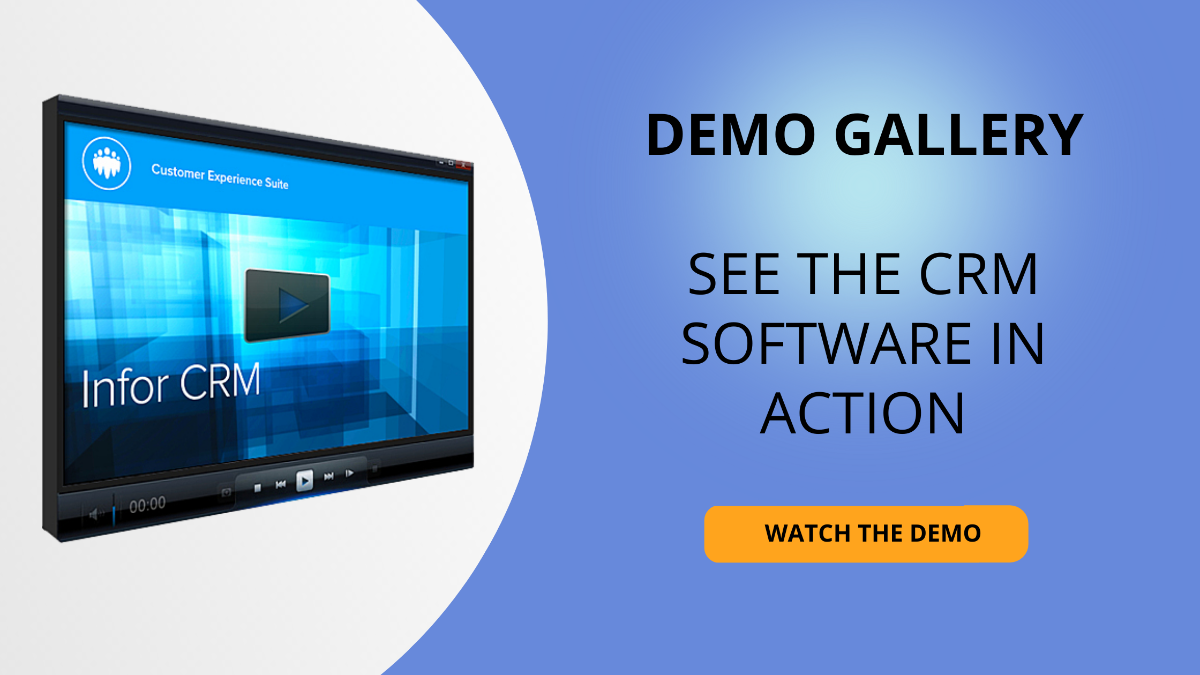
Table of Contents:
5 CRM Issues Manufacturing Companies Can Avoid
CRM project planning reduces CRM problems
Customer relationship management (CRM) software can be extremely beneficial in streamlining the sales process for manufacturing companies, providing the CRM project is structured properly. You probably don’t deal with buying and implementing software every day, but we do. Or experience in assisting hundreds of other companies in the selection and implementation of CRM allows us to guide you through this process. Here are five CRM issues and problems you need to be aware of so you can make the most of your efforts.
CRM issue #1: Your company needs CRM software and doesn’t have it.
One of the telltale signs that your company can benefit from CRM software is the number of spreadsheets used to manage the customer base, sales cycles, and follow-up items. The more spreadsheets you use, the more you need CRM software.
The beauty of spreadsheets is that they are easy to use and powerful—and, a better solution than having nothing. The problem with spreadsheets is they are an island of information. It contains data, but that data is not connected to any other data. The fact that you need many spreadsheets reinforces the fact you have stand-alone, non-integrated data. Also, spreadsheets don’t tell the whole customer relationship story. You can’t analyze a single spreadsheet and know: How many open invoices does a customer have? How do sales this year compare to last year? Are there any open quotes that need a follow-up call?
What you want is a 360° view of your customer in one database. You want this because, like anything else in life, if you want to improve you need to know where you’re at compared to where you want to be, develop a plan to get there, and measure your progress against that plan. Trying to achieve this with a myriad of spreadsheets will hinder your results. Your company will not be the best it can be.
CRM software solves this problem. However, searching for and then implementing the right CRM solution can lead to four other issues, so keep reading.
CRM issue #2: You have the wrong CRM project team.
The purchase and implementation of CRM software is not a project IT should lead. IT should, however, play a supporting role. Who are they supporting? They are supporting whoever is responsible for the customer relationship, which is typically a sales management role.
Keep in mind that CRM is a tool, not a solution. The solution is always a combination of people and processes. Software is the tool that people use as they follow the process put in place. IT supports the people and the process by assuring that the tool is performing properly. Any variation of this mindset is usually a recipe for disaster.
The CRM implementation team should consist of the person with overall responsibility for the customer relationship along with some users of the CRM.
CRM issue #3: You don’t value the integration between CRM and your ERP system.
The team that is evaluating and implementing CRM software needs to understand where CRM fits into the rest of the organization. Although it might be tempting to buy an off-the-shelf, stand-alone CRM system (“Look at all the money we’ll save!”), don’t do it. If you do, all you have done is grouped your many islands of information into one bigger island. All of the quotes, orders, shipments, and invoice information is in your ERP software and is part of the 360° customer view you want.
Once you price out integration of the stand-alone CRM with your ERP system, the “savings” will quickly evaporate, and changing versions of either software could require modifications to that integration.
Value the beauty of an integrated CRM/ERP system. Long term, it is your most cost efficient path.
CRM issue #4: Your goals for CRM are not defined properly.
The problem is that a lot of the goals created aren’t actually goals at all—they are a description of software features.
Goals are related to the business, not the software. For example, looking up customer information on a handheld device is not a goal, it’s a feature. Creating a system that allows you to quickly answer any customer question related to quotes, orders, shipments, and invoices without having to call them back is a goal. Looking up customer information on a handheld is a software feature that supports the goal. CRM stores the customer data—another feature that supports the goal. Notice how a good goal unifies different features of the software and gives them purpose?
CRM issue #5: Your data collection requirements are not realistic.
Did you know if you feed a starving person too much right away they can die? It’s called refeeding syndrome. Basically, the body did the best it could to adapt to the extended fast; it needs time to begin processing again. Feeding someone too much too fast could cause the body to shut down completely.
How is this related to CRM issues? Your sales team has been undernourished for years trying to sustain themselves with spreadsheets and post-it notes. CRM can provide a tremendous amount of data, so the tendency is to want all of it! Let’s track the square footage of the customer’s facility! Let’s put spouse’s names in the contact record! Birthdays—we need birthdays! This is going to be great! Trust me: This is a very seductive trap to fall into.
Don’t go overboard with the data you collect. Focus on what you need, not just what the CRM software can store. Any CRM software can store more information than you need. It’s OK to ignore what you don’t need. Here’s the reality: CRM implementations fail because required data is not entered into the system. Now, you can focus all your resources and spend all your employee goodwill on making sure all square footage, spouse, and birthday information is entered properly. Will your company reach its performance goals if you gather all this information? Chances are, it won’t. Chances are, your performance goals will be ignored and the focus shifts to gathering information that won’t help you. Not a good situation.
If you needed such detailed information to be successful, you would have already created a spreadsheet to store it. Here’s the simple truth: Data collection is not free. The more information you require, the more it costs you. If you require too much, the CRM software becomes too difficult to use, so employees stop using it. They still need something to help them manage their data though, and the solution they come up with will sound familiar—the very same spreadsheets you started out with.
Less truly is more.
Remember, even if the only information you put into your CRM is exactly what you were tracking in spreadsheets, you have taken a big step. All the information is in one spot. It can be tracked and measured. It is accessible and gives you a 360° view of your customer.
Strategy for Selecting a CRM Solution
Do your homework
Often times I get asked by potential CRM customers what CRM system they should buy. My answer is usually, “It doesn’t matter.” If you are going to choose the CRM system without doing your homework, any system will work equally as well, or as poorly, so just pick the cheapest. However, if you are going to do your homework and make the decision that best fits your company, you have a long way to go before choosing the CRM system that makes sense. So if this is the case, then what should you consider before purchasing a CRM System?
Things to consider
The first thing you should consider when purchasing a CRM system is the goal of purchasing this system. Is the goal to track your sales force? Is the goal to make your sales force more productive? Is the goal to maintain your customer base or to raise your customer base? If a year from now you were trying to decide if the purchase was successful, what would be the criteria you would use to say this met your needs?
Next make sure you have your management team bought into the process. This is more than just saying they have signed off on the budget or funding. This means that they truly believe a CRM system will benefit the company in order to achieve the goals mentioned in the previous paragraph. The management team needs to own this system and support it throughout the company. They need to be users of the system and the information it provides. They need to demonstrate the discipline that this system is an integral part of doing business.
Related: 5 Customer Relationship Management (CRM) Issues Manufacturing Companies Can Avoid
Once the management team is bought in to the idea of a solution, build a CRM steering group to help you through the process of choosing and implementing a CRM system. This team should include at least one person from each of the stakeholder groups. CRM spans marketing through order fulfillment, it is not just sales, so make sure all of those groups are represented.
Next, start to determine the necessary functionality of the system for each group. It is important that there is a benefit to using the system for each group, or they won’t use the system - Sales is particularly tough here. It is easy to come up with a lot of benefits the company will get from a CRM.
- Centralized data
- Reduction of disruption due to turnover
- Visibility into forecast
- And many more
However, none of these really benefit the individual salesperson. In order to insure adaption, there has to be a reason for the salespeople to use the system. Some examples are:
- Data organization
- Marketing automation providing high quality leads
- Insight into the order fulfillment process making it easier to answer customer request
- Insight into order fulfillment process giving the salespeople an understanding of where they currently stand toward goals, and a roadmap for places where they can find revenue when they need to close more business to achieve those goals.
- Answers to how the customers’ relationship is going with the customer service function; the last thing a salesperson wants is to be blindsided to an issue when they walk into a customer.
Prioritize this functionality into “must have” and “nice to have”. Typically many organizations either go after the “nice to have” which is a risk for failure, or never get to the “nice to have” and that reduces adoption.
A budget for your CRM purchase
Once you have itemized your needs, address a budget. There are really two ways of accomplishing this. Top down based upon a number management gives you, or a percentage of sales. Or bottom up where you address all the pieces that make up the CRM system and the associated cost with each. Even if you do the top down it is still important to understand the cost of implementing CRM. The cost of the software is just a small piece. Here are a few items to consider when implementing CRM.
- Hardware for the individual users
- Location of the sever/database (on premise or in the Cloud)
- Security
- IT expertise and availability
- Support
- Training
- Cost of software
Integrating CRM
Another item to consider and understand is integration to other systems. You are most likely going to have integration to your email system. For most CRM solutions this is a given. You may also have integration to your back end ERP system. Often times this is a critical component of the overall CRM solution. Staying within a one vendor strategy for ERP and CRM can contribute to a successful CRM implementation, however it isn’t mandatory. Most ERP integrations include a one way flow of fulfillment information from ERP to CRM.
- Quotes
- Orders
- Shipments
- Invoices
- Receivables
- Payments
Typically going from the CRM to the ERP system are Accounts/Contacts and Quotes.
The CRM solution
Once you have determined the above, it is time to determine the CRM solution. Many of the decisions you have made above will narrow down the choices for your CRM solution.
Related: Infor CRM Review: Overview, Features & Implementation
It is fairly easy to set out a list of must haves and infrastructure needs and then narrow down the solutions that fit your needs. Some people will do an RFP which can be a fairly lengthy process. Some people will narrow down the solutions to two that best meet their needs based upon research, and then do a bakeoff-type of selection. Having an implementation partner that is product agnostic as part of this selection process can be a tremendous benefit.
Make sure to vet the solution properly. Most references a vendor provides are going to be positive. Make sure you have a list of questions that will bring out specifics about the implementation. Ask questions about timing and delays and what caused these. Ask questions about how they are measuring the utilization of the CRM and how they are measuring the success. Try to get an understanding of how they prioritized their implementation. These types of discussions will uncover issues and will help you avoid the typical answers that come with any reference call.
See CRM software in action
Check out companies using CRM
Once you have isolated the solution you want to implement, consider a site visit to a company already using the product. These are sometimes difficult to coordinate because everyone is busy these days. But a site visit can often bring out other concerns you should be aware of.
Select an implementation partner
Once you have arrived at this point, you should then negotiate the acquisition of your solution with the provider. Be aware of the provider’s public reporting cycles which typically get very aggressive near the end of the month/quarter/year. Work with the provider to select an implementation partner or use the one that helped select the solution, and then you are ready to begin you CRM implementation.
Visual South has experience in assisting hundreds of companies in the selection and implementation of CRM. Contact us if you'd like to talk.
How To Run A CRM Testing Process
CRM testing and emotions
Before I explain what goes into CRM testing – which is basically all logic – I’d like to review the emotional side of testing. I’ve never met anyone who disagreed with the premise of testing. After all, what is there to disagree with? The logic is pretty straight forward: The company makes a substantial investment in CRM; new processes are developed to take advantage of what CRM can offer; let’s test it before we use it.
See Infor CRM in action
Yet, not every company tests CRM fully before it goes live. Why? Emotion takes over and logic is twisted to convince a company that, “We’ll be fine.” Why does this happen? Here are a few reasons:
- We ran out of time
- We’ll fix whatever problem we run into
- No one trained properly and their failure will teach them a lesson
- This will force people to learn the system
Don’t these reasons sound like nonsense? That’s because they are when you look at it logically; and chances are that’s the mindset you’re in now. Remember this moment when you are in the throes of implementation and a deadline is looming. That’s when emotions enter in the thought process and things you thought were silly start sounding reasonable.
Remember this also: Everyone will train on the new CRM system. The only question is, will they train before you go live or after? Going live before employees are trained creates enormous problems that could derail the entire CRM system.
Now let’s go over the CRM testing process.
CRM testing: The basics
The basics have nothing to do with people and training; it’s all about data. In essence, this is an IT exercise. Make sure the data is correct and in the accurate fields. Test that the data flows the way it was intended to flow. Check that the security settings are appropriate to the user. Test the integrations (if any) to make sure the triggers are working and the data is flowing properly.
This is the easiest part of the testing because, unlike employees, data doesn’t have to learn anything new. Data doesn’t have to train and learn a new skill set.
Related: 5 CRM Mistakes to Avoid
CRM testing: The users and processes
This is the part of CRM testing that determines the success of your implementation project. It’s important to understand what is being tested in this phase. It’s not the software. You are testing the user’s ability to use the software. This is a critical distinction that must be understood. Think of it this way: If you get on a plane and I’m the pilot, get off the plane! Not because there is anything wrong with the plane, but because I don’t know how to fly it.
The goal in this phase is for the user to prove to themselves – and to management – that they can do the job that is expected of them. When this is achieved for all users, everyone’s confidence level is high and the launch of your new CRM application, and process, is successful.
The testing should include a list of normal, real-life scenarios. These should be situations where an employee has to use the system to find data someone else has left for them, or has to add data for someone else to find. Here are some examples of CRM testing scenarios:
- An outside sales rep leaves a task for an internal sales rep to call a contact after a customer visit
- A rep has to determine their open opportunities
- A rep needs to define any situations they should know about before a customer call
These are simple examples, but they all have one thing in common: Users must employ CRM to get answers or to know what to do, as opposed to looking at an email or having a conversation with another employee. For this reason, it’s important that not everyone is in the room at the same time when testing. If one of the scenarios is the rep leaving a task for someone else to call a contact, don’t have both people in the room when the task is created. Ensure that the rep knows how to leave a task, and the person assigned a task knows it’s there.
You will have many more scenarios than the few I’ve listed, but understanding the concept behind the CRM testing process will lead you down the right path.









